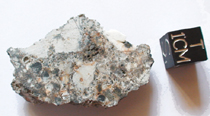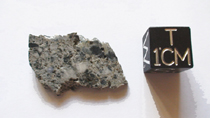Aubrites
The aubrites are named for Aubres, a small meteorite that fell near
Nyons, France, in 1836. Consisting primarily of the orthopyroxene
enstatite, they are also called enstatite achondrites. Aubrites represent
evolved rocks of igneous origin and are not to be confused with primitive
enstatite-rich achondrites such as Zaklodzie or Itqiy. Due to their
typical light-colored fusion crusts, their white interiors, and their
fragile compositions, most aubrites in our collections are witnessed falls
or finds from the blue-ice fields of Antarctica. Excluding all probable
pairings, only 16 distinct members are known. Strangely, very few aubrites
has been recovered from the hot deserts. Aubrites are very rare
achondrites.
|
Khor Temiki
Aubrite
fell -- 18 April 1932 Gash delta, Kassala, Sudan
TKW 3.2 Kg
|
 
|
|
|
|
Khor Temiki
-00
mislabeled, Mayo Belwa
large end cut with vacuoles
9.81gr
SOLD |
|
|
|
|
|
|
|
Khor Temiki -01
large slice with vacuoles
2.33gr
SOLD
|
|
|
|
  |
|
|
|
|
|
|
|
|
|
|
|
|
|
|
|
|
|
|
|